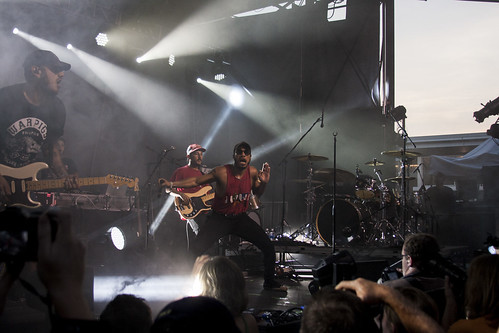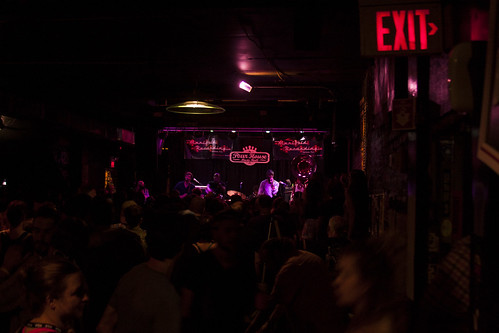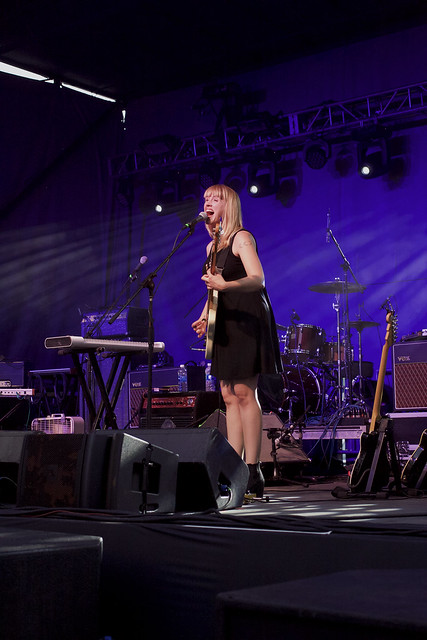 Jasper asked Free Times music editor emeritus, Those Lavender Whales guitarist, and Hopscotch veteran Patrick Wall to go the festival and gives us his thoughts. This, in three parts, is what he wrote.
Jasper asked Free Times music editor emeritus, Those Lavender Whales guitarist, and Hopscotch veteran Patrick Wall to go the festival and gives us his thoughts. This, in three parts, is what he wrote.
Part I is here.
--

Let the drummer get some, sure. But this was fucking ridiculous.
The rumors started flying some time during Anderson.Paak’s electric mid-bill set at City Plaza. Erykah Badu — the festival’s marquee name, scheduled to go on at 8 p.m. at the Red Hat Amphitheatre — had missed her flight out of Dallas. Her set would have to be postponed. If there was any official announcement from Hopscotch, it went entirely unnoticed.
(Quick aside: Anderson.Paak’s might have been the best set of the festival. It was certainly the best City Plaza set, though it’s followed closely by Vince Staples’ Saturday night slammer.)
Come 9 p.m., after Paak’s magnetic performance and a workmanlike, though perhaps a bit staid, blues ramble from Gary Clark Jr. at Red Hat, Badu still hadn’t taken the stage. Rumors started flying again — she’d missed another flight, and her performance would have to be delayed again.
Only at 10 p.m. did Badu’s band take the stage, though they only launched into a meandering funk jam. Five minutes in, the drummer began his solo. Five minutes later, when it was time for the bassist’s extended solo, I threw up my hands, exited the photo pit, got on my bike, and high-tailed it to Memorial Auditorium, where Boulevard’s Jamil Rashad, shirtless and glistening with sweat, was leading a master’s course in gritty, urbane funk.
Badu didn’t take the stage 10:15 p.m., until more than two hours past her scheduled start time. Hopping from Boulevards to Dai Burger, who delivered an animated, regenerative set at Lincoln Theatre, I could hear her songs echoing down Cabarrus Street. Thankfully, it wasn’t “Trill Friends,” or her long-ago hit “Tyrone” — if it were either, I’d probably have lost it.
For the first time, the headlining shows were split across two venues: City Plaza, where Hopscotch headliners have played every year, and the Red Hat Amphitheater, a venue a five-minute walk away but one the festival has long avoided nonetheless. But its size and permanent stage allowed Hopscotch to expand its talent roster considerably this year and bring in some marquee names. If night one felt like a confirmation of Hopscotch’s past, night two offered something of a glimpse into its future, of Hopscotch’s need to balance growth with dependability and intimacy. By adding Red Hat this year and by putting Memorial Auditorium back in the rotation after a two-year absence, Hopscotch, of course, increased its star power and ticket-selling potential. (And increased its need for sponsors: Street-team reps from Motorola, Mati energy drinks, Kind bars and Mist Twist soda were slinging product and vainly soliciting mailing list signatures at seemingly every outdoor concert area and alternate intersections.)
Either way, the moves weren’t a resounding success. Both stages were running behind all night, as was the City Plaza stage. Young Thug, too, went on more than an hour late. Delays are inevitable, situations like Badu’s certainly can’t be blamed on Hopscotch. (And laying the blame squarely on the festival seems reductive.) But the lack of any communication and seemingly any contingency plan was certainly frustrating. At Hopscotch, time is money, and spending hours of your night waiting for sets to start can be an extravagant waste when so many other things are happening. Pervasive delays sour the implicit relationship between festival and fan, and the timing tangles left many festivalgoers stripped of agency. If the entire point of a festival like Hopscotch is to control your own destiny — and I argue it is — then it’s reasonable to be exasperated when waiting to see one act prevents you from seeing several.
More than simple inconveniences, the timing tangles also highlighted Hopscotch’s issues with its black audience. As Indy Week’s indispensable Eric Tullis wrote in his night three recap, Hopscotch has never seemed able to draw as many African-Americans as it did for Badu’s set. Not for Public Enemy in 2010, nor The Roots in 2012, nor De La Soul in 2014. And as Gary Suarez wrote in Indy Week, Hopscotch still proves somewhat vexing to the hip-hop fans — of any color — it seeks to draw. Scheduling matters, and nothing makes that concern clearer than when rap shows are competing with one another on one day and woefully scarce the next. Hip-hop was confined to Deep South CAM Raleigh on Friday night; if you wanted to see Kelela and Well$ and, say, Tom Carter and Converge, well, they were on opposite ends of the festival at the same time. Young Thug, if he’d made the stage on time, had a prime time slot at Memorial Auditorium, but that meant missing some or all of Hellfyre Club alumnus Milo at Kings, or Ratking's Wiki, or Raleigh crew Kooley High, or the stacked bill at Lincoln Theatre that featured Queens rapper Dai Burger, footwork don DJ Spinn and Big Freedia. Waiting around for Young Thug meant sacrificing those opportunities entirely. Saturday didn’t feature much rap at all. Such scheduling is advantageous for the casual hip-hop fan, but a drag for die-hards who wanted to spend time in more than one place.
And programming artists with broader mainstream appeal and wide reach, like Badu and Staples and Paak, invites more and more casual fans, who don’t care too much about running around and seeing bands in clubs. The outdoor stages (and some of the bigger indoor ones, like Memorial) were flush with folks who would not be interspersed among the festival’s club crowds afterwards, and the strange and at times overwhelming racial disparity of that crowd was at times unavoidable. Young Thug’s crowd was mostly white, and many of them were rapping the N-word. (To which: Y’ALL.). Paak, for his part, observed that he “didn’t expect to see so many white people” at his City Plaza performance, and Vince Staples — who performed his tales of gangbanging and living in a world in which he questions the motives of people who don’t look like him to those exact people in City Plaza, who were mouthing every word his songs — left the City Plaza stage without so much as acknowledging the predominantly white crowd once. Only Erykah Badu’s crowd seemed, at the very least, evenly mixed along racial lines.
Perhaps Staples makes the most salient point in his own music: “All these white folks chanting when I ask em, ‘Where my niggas at?’” he raps on “Lift Me Up” “Got me goin’ crazy, I can’t get with that.”
He performed the song at Hopscotch. Hearing the crowd rap that line with him was an interesting example of white privilege — as much as the cotillions and debutante balls at the Marriott and Sheraton hotels that Hopscotch seems to bust up every year.
+++
Friday happened to be Wooden Wand leader James Jackson Toth’s birthday. So he and exemplary solo guitarist Daniel Bachman, with whom he was performing a set at the always impressive Three Lobed Recordings and WXDU-FM day party at Kings Barcade, were probably in a celebratory mood. On a lark, they threw together a combination of players that had never played together before — Bachman, Toth, Forrest Marquisee on guitar, and Ian McColm on drums — and didn’t bother to rehearse or soundcheck. For the first few minutes, McColm and Bachman pumped harmonizing drones on odd squeezebox-type instruments, while Marquisee and Toth tentatively picked fragile arpeggios on their guitars. Three minutes later, and Toth croaked the first lines to Black Sabbath’s “War Pigs.” The crowd, which packed Kings from stage to soundboard and beyond to the back windows, roared.
After a brief break, Three Lobed Recordings’ big experimental shindig — a veritable Hopscotch tradition (indeed, some folks trek hundreds of miles just to see Cory Rayborn’s exciting day party, and don’t even attend the festival) — returned to Kings. Though it was only gone for a year, Hopscotch felt different without it.
Day parties are an integral part of the Hopscotch experience. Since its debut, Hopscotch has — both officially and unofficially — included a host of free daytime shows sponsored by local and national benefactors to fill up the space between the festival's evening sessions. These opportunities make Hopscotch's annual takeover incredibly inclusive. And, to local and regional bands — especially those from South Carolina, in recent years — day parties offer a chance to get in on the action.
At three jam-packed nights, Hopscotch would be a big to-do by itself. But the action during the days turns the long weekend into a real party, and local organizers have built out events, like the Three Lobed day party or the annual pizza party hosted by the local Potluck Foundation record label, into traditions as nearly as strong as Hopscotch. As the festival has grown, so, too, have the diurnal events gotten bigger and better in their scope. Where day parties were once easy ways to solve nighttime scheduling conflicts, day parties now make for many more tough decisions. Since these day parties have never required actual festival passes, it's largely one of those good problems to have.
Indeed, having the Three Lobed party back on the slate is a welcome course correction, and it allowed, potentially, for the clearing of some logjams. (For instance, in catching the wily ür-rock band 75 Dollar Bill at Kings on Friday afternoon, I was able to simplify my Thursday hopping.) But its inclusion puts into contrast that the tide of Hopscotch’s avant-garde leaning is changing — and possibly waning.
Hopscotch built its reputation in part on being wonderfully weird. 2012, the festival’s third year, was a banner year for the weird: Chris Corsano was the improviser-in-residence; minimalist icon Arnold Dreyblatt sat in on a performance with boundary-pushing psych-folk band Megafaun; legendary free-ranging underground rock act Oneida held a long and limber jam session in the middle of downtown Raleigh. Drones abounded, from Oren Ambarchi's glistening tones to Sunn's overwhelming roars. Even among excellent rock and pop acts, those artists pushing the outer edges of sound shone.
The avant-garde has certainly still been represented — Thurston Moore, Tony Conrad, Hawkwind, Tim Hecker, Ian William Craig, Zeena Parkins, Zs, Matmos, Charlemagne Palestine — since, but the density and focus hasn't been the same. Instead, these outer-limits bookings are just one modest part among many, rather than being a defining feature of the festival. The difficult music seems less difficult.
This year’s lineup stacks acts who plumb the deepest depths of their genres (see: Erykah Badu, Vince Staples, Yob), but the true experimental performers seemed to slot perhaps too easily into necessary signifiers. John Colpitts, aka Kid Millions, was the festival’s de facto resident improviser, collaborating with harpist Mary Lattimore and psych-rock band Birds of Avalon and Borbetomagus saxophoner Jim Sauter, and performing with his own minimalist percussion crew, Man Forever. Battle Trance was the token "jazz” group (even though the quartet fits the label oh so loosely); William Basinski, the composer.
It’s hard not to wonder if this imbalance is sign that Hopscotch is losing ground to Knoxville’s Big Ears as the vanguard festival of the accessible avant-garde, or even MoogFest, which now operates in Durham after migrating to the Triangle from Asheville. Part of what has made Hopscotch special — and exciting— has been the way it has treated the avant-garde with the same esteem as it did the most accessible of its pop acts, pushing the fringe to the forefront in ways that other festivals dared not attempt. With festivals like Big Ears and Moogfest infringing on that territory, Hopscotch, it could be argued, is that much less special, and perhaps worse for the offering. Variety and name recognition are good problems to have, but at what expense the festival’s soul?
The counterargument, of course, is that you never know who will attend because of one or two big acts — say, Erykah Badu, or Young Thug — and may just have their mind blown unexpectedly by an outsider act or others in a similar creative vein. But my anecdotal evidence — read: the two hipster white girls who giggled at every flatulent bleat or any other extramusical noise produced by Battle Trance that sounded remotely like a bodily function, and the sparse crowds for William Basinski, Tom Carter and Leila Abdul-Rauf versus packed rooms for outwardly appealing acts like Boulevards and Big Freedia — suggests otherwise.
Which is what made Bachman, Toth and crew’s version of “War Pigs” so noteworthy. Like the dehydratingly choogling version of the Velvet Underground’s “Oh, Sweet Nothing” by Desert Heat — a guitar supergroup featuring Steve Gunn and Cian Nugent — at a Three Lobed party a few years back, it was one of those off-the-cuff, daring improvisational moments that have come to define the Three Lobed day parties — and, in some ways, the festival itself.
+++
To be continued…
Patrick Wall is music editor emeritus of Free Times. He now lives in Winston-Salem, North Carolina, where sometimes people pay him to write things. He is carbon-based.
 Jasper asked Free Times music editor emeritus, Those Lavender Whales guitarist, and Hopscotch veteran Patrick Wall to go the festival and gives us his thoughts. This, in three parts, is what he wrote.
Jasper asked Free Times music editor emeritus, Those Lavender Whales guitarist, and Hopscotch veteran Patrick Wall to go the festival and gives us his thoughts. This, in three parts, is what he wrote.




